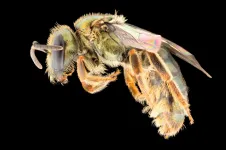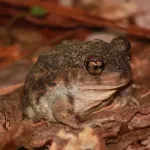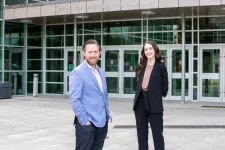(Press-News.org) After centuries of human impact on the world's ecosystems, a new study from Flinders University details an example of how a common native bee species has flourished since the very first land clearances by humans on Fiji.
In a new paper in Molecular Ecology (DOI: 10.1111/mec.16034), research led by Flinders University explores a link between the expansion of Homalictus fijiensis, a common bee in the lowlands of Fiji, which has increased its spread on the main island Viti Levu alongside advancing land clearance and the introduction of new plants and weeds to the environment.
"Earlier research connected the relatively recent population expansion to warming climates, but our study reveals an interesting and positive response from an endemic species to human modifications to the landscape which commenced about 1000BC," says lead author, Flinders University researcher James Dorey.
"This species is a super-generalist pollinator (pollinates many plant species) and likes to nest in open, cleared ground, so one of the most important bee pollinators in Fiji actually appears to have benefited from human arrival and subsequent clearing of land in Fiji."
The study examined changes in native bee populations in Fiji using phylogenetic analyses of mitochondrial and genomic DNA. They show that bee populations in Fiji expanded enormously, starting about 3000 years ago and accelerating from about 2000 years ago.
Compared to the main island, Mr Dorey says no corresponding change in bee population size was found for another major island, Kadavu, where human populations and agricultural activities have been historically very low.
"That is too recent to be explained by a warming climate since the last glacial maximum which ended about 18,000 thousand years ago," says senior author Associate Professor Michael Schwarz in the new paper.
"Instead, we argue that the expansion of Fijian bee population better coincides with the early occupation of the Pacific islands by the somewhat-mysterious Lapita people, and this expansion accelerated with increasing presence of later Polynesians in Fiji who modified the landscape with their agricultural practices."
The research is an example of how the impacts of early human dispersals can be inferred even when fossil records are not available and when climate change is a complicating factor.
One possible downside of super-generalist pollinators, such as the endemic Fijian halictine bee Homalictus fijiensis, is that they could encourage the expansion of introduced weeds and exotic crop species - exacerbating other ecosystem changes in the long run.
"As well, those research techniques could be applied to many other animal species. For example, changes in population sizes of mammals, such as kangaroos, wombats and koalas, could be explored by looking at their tick and lice parasites which might have better 'genetic signals' of how populations have fared over the last few thousands of years or more, adds Associate Professor Schwarz, who says high-resolution population genetic studies such as this are a good way to discriminate between older and 'natural' events due to climate change and those resulting from early human dispersal and colonisation.
"A persistent question in studies of ecosystems over the last 60,000 years or so concerns the relative roles of climate change and human modifications of the environment. For example, there is a continuing debate about the extinction of megafauna in Australia - was it due to humans, climate change, or both?
"Those kinds of question can be addressed if there are very good fossil records, but what about ecosystems where fossil records are very poor."
The new paper is a result of almost a decade of scientific studies into Fiji's biodiversity by SA Museum and Flinders University biological scientists and students.
SA Museum's research fellow in World Cultures, Dr Stephen Zagala (pictured attached), says the new study gives fascinating insights into how current ecosystems were assembled during the various phases of human migration and settlement.
"Early European explorers and naturalists were unaware that extensive human dispersals had already been transforming the ecologies of Pacific islands for millennia," he says. "This study adds important details to an emerging picture of the Pacific as a highly cultivated landscape."
INFORMATION:
The article, Holocene population expansion of a tropical bee coincides with early human colonisation of Fiji rather than climate change (2021), by James B Dorey, Scott VC Groom, Alejandro Velasco-Castrillón, Mark I Stevens, Michael SY Lee and Michael P Schwarz has been published in Molecular Ecology (Wiley) DOI: 10.1111/mec.16034
What is unique about the study is the combination of interviews with current and former people in prison, custodial professionals, and healthcare providers to identify and understand barriers in delivering high-quality healthcare and support to those in custody. In addition, researchers gathered data on the number, types and stages of cancers diagnosed in patients within prisons.
Moving forward, the researchers believe that findings from this study will help inform prison cancer care policy and develop priorities for improving it within the prison system. The research was funded by the National Institute for Health Research (NIHR), the research partner of the NHS, public health and social ...
Arlington, Va., June 29, 2021 - In the midst of the COVID-19 pandemic, infection preventionists at two Southern California hospitals took extreme measures to stop the spread of a deadly fungus that has emerged in the U.S. and around the world. The two will detail their proactive responses in oral presentations today at the Association for Professionals in Infection Control and Epidemiology's (APIC's), 48th Annual Conference.
In separate responses, Scripps Memorial in La Jolla and UCLA Health in Los Angeles isolated suspected or confirmed patients, worked closely with public health departments and information technology and lab teams at their facilities, and implemented aggressive measures ...
The devastating 2012 - 2016 drought in California triggered widespread tree cover loss and die-offs of a variety of species in the region. A new study in the open access journal Frontiers in Climate is the first to show that California's iconic blue oak (Quercus douglasii) woodlands have also decreased by more than 1,200 km2. By another metric, which reflects the altered or deteriorating condition of the tree cover, the blue oak range has lost over 600 km2 in addition. These findings highlight the need to raise awareness about the vulnerability of these ecosystems and to adapt conservation strategies to increasing climate extremes.
"Our ...
Black men most likely to benefit from advanced prostate cancer therapies are 11 percent less likely to get them than non-Black men. This happens despite apparent equal opportunities in obtaining health care services, a new study in American veterans shows.
Publishing in the journal Cancer online June 29, the study showed that Black male veterans were slightly (5 percent) more likely to receive radiation or surgery for prostate cancer than non-Black men and that veterans of all races likely to benefit from such definitive therapy were also 40 percent more likely to get it compared to those who did not need it.
Led by researchers from NYU Langone Health and Perlmutter Cancer Center, the new analysis showed ...
A new paper in JNCI Cancer Spectrum, published by Oxford University Press, indicates that many survivors of adolescent and young adult cancers hesitate to obtain COVID-19 vaccinations.
As of March 2021, there were over 33 million cases and 580,000 deaths from COVID in the United States. Vaccines offer the best hope to control the spread of COVID-19. Some 20%-40% of the US population, however, is hesitant to obtain COVID-19 vaccination. Cancer survivors often have weakened immune systems and are more likely to develop severe respiratory infections, making them particularly vulnerable to the threat of COVID-19.
National organizations recommend strongly ...
According to the World Health Organization, about 785 million people around the world lack a clean source of drinking water. Despite the vast amount of water on Earth, most of it is seawater and freshwater accounts for only about 2.5% of the total. One of the ways to provide clean drinking water is to desalinate seawater. The Korea Institute of Civil Engineering and Building Technology (KICT) has announced the development of a stable performance electrospun nanofiber membrane to turn seawater into drinking water by membrane distillation process.
Membrane wetting is the most challenging ...
CORVALLIS, Ore. - Research by a graduate student in Oregon State University's College of Science has upended the conventional wisdom that for a century has incorrectly guided the study of a toad listed as endangered in part of its range.
Anne Devan-Song used spotlighting - shining a light in a dark spot and looking for eye reflections - to find large numbers of the eastern spadefoot toad. The study illustrates how confirmation bias - a tendency to interpret new information as ratification of existing theories - can hamper discovery and the development of better ones.
Her findings, which show that the toad spends much more time above ground than commonly believed, were published in the Journal ...
Chestnut Hill, Mass. (6/29/2021) -- A new, first-of-its-kind study led by researchers from Boston College has found that personal networks in India could play an important role in advancing the adoption of a cleaner cooking fuel, in this case liquefied petroleum gas, according to a report published in the journal Environmental Research Letters.
"This is the first report in clean cooking research to show that just like with tobacco use, obesity, or physical activity -- where our networks play a role in shaping our behaviors and decisions -- we find that personal networks are also associated with what kinds of stoves rural poor use.," said study co-author ...
The tiny mouse embryo has a heart that beats. Its muscles, blood vessels, gut and nervous system are beginning to develop. But this embryo is unusual: It was made in a lab, out of mouse embryonic stem cells, and represents the most sophisticated in vitro (in a dish) model of a mammal ever so created.
This new model, developed at the University of Virginia School of Medicine by Christine and Bernard Thisse, is a major step forward in scientists' efforts to mimic the natural development of a mammal by using stem cells. Its existence is a wonder that will help scientists understand mammalian development, battle diseases, create new drugs and, eventually, grow tissues and organs for people in need of transplants.
"We found a way to instruct aggregates of stem cells to initiate ...
Immunologists at McMaster University have discovered a previously unknown mechanism which acts like a spider web, trapping and killing pathogens such as influenza or SARS-CoV-2, the virus responsible for COVID-19.
The researchers have found that neutrophils, the most abundant white blood cells in the human body, explode when they bind to such pathogens coated in antibodies and release DNA outside of the cell, creating a sticky tangle which acts as a trap.
The findings, published online in the Proceedings of the National Academy of Science, are significant because little is understood about how antibodies neutralize viruses in the respiratory tract.
The discovery has ...




